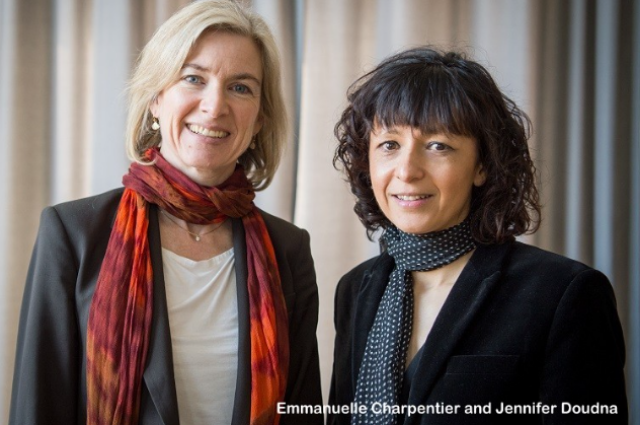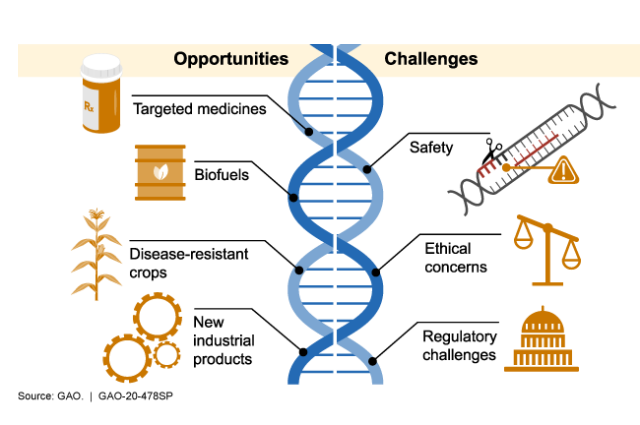
Ever wondered how a single letter can change someone’s fate or species forever? When our entire genome is based on a sequence of only four letters A,T,C and G the significance and the potential consequences of these letters, which represent each nitrogenous bases, becomes clear. Ever since the Human Genome Project, which has enabled us to chemically pin-point each and every nucleotide at even the most remote part of the smallest human chromosome, several researches have undergone to modify the genomic sequence to treat several genetic disorders and shortcomings, for which we had no previous effective remedies. So, when the most precise technology of genetic engineering, CRISPR-Cas9 Genome Editing, was developed by Emmanuelle Charpentier and Jennifer Doudna, the Nobel Prize of Chemistry for 2020 was firmly secured by their revolutionary discovery.
Significance of CRISPR
Although we know the entire genomic sequence of the human genome, apart from several plants and microorganisms, the exact functions of each and every gene is still beyond human comprehension. As a tool to understand the underlying functions of genetic expressions, CRISPR technology interferes with the genetic expressions, by enabling the molecular biologists to customize the gene expression of a particular gene in a DNA very precisely. While the applications of this technology are exponentially increasing, the ethical constraints of the technology are currently without a firm grip. International molecular biological authorities are still debating about the extent of CRISPR applications, how accessible should CRISPR be and the laws governing international and domestic regulations governing inappropriate and unethical CRISPR utilization.
Phenomenal in Promises

Much of the discussion about the risks of CRISPR technology has focused on using it to edit the human germ line. The full extent of how can CRISPR be used for greater good can be realized by its ability to cause directed evolution. Even after thousands of years, the human genome could not eliminate its genetic defects which has always plagued the population. Modern science with its gene therapy, enzyme therapy all were symptomatic because they addressed the effects but not the root cause. CRISPR gene editing will not only help to eliminate the harmful genes like genes for sickle-cell anemia, thalassemia, to name a few, but also progressively remove them from the genetic pool of the entire human species. This may sound as an extremely dangerous and faulty plan, but it isn’t so. Genetic defects will continue to rise naturally due to DNA’s innate ability to slowly mutate. CRISPR can only help to remove the harmful mutations. This is directed evolution, humans capable of directing their own evolution, a choice to lead a better life.
Legal Question and the Grey Areas
Now the crucial question arises: Will CRISPR gene editing technology serve for a greater good or would be misused? The answer however is not as precise as CRISPR..! While the technology itself has a lot of potential to be misused and cause devastating and long-lasting effects, it cannot structurally support an argument valid enough to offset the great benefits that come with it. Numerous technical difficulties are still present in the procedure, like the Cas9 enzyme, the backbone of CRISPR, can go off-target and trigger changes to undesirable genes, which can have cascading effects in the physiochemical scenario. Without discussing the realistic technical difficulties, the implied ethical concerns are not only simple intellectual acrobatics, but also akin to building castles in the air. Sure, there are a few cases like the Chinese researcher, Dr. He Jiankui, who was sentenced to imprisonment for carrying out CRISPR gene editing in 3 infants last year, who actually forged approval documents. However, this may be attributed to the lack of governing rules regarding the use of CRISPR, and not the fictitious and falsely assumed negativity of the technology itself. The risks of the applications should serve as a call for discussing domestic and international regulation and guidelines for CRISPR's use.
When it comes to conducting live experimentation, and at the extreme end, trails on humans, it comes to an extremely grey area with potential pitfalls for a person with weak morals and ethics. Now, let me present a question, can scientific knowledge, or more importantly biological knowledge progress without animal experimentation? Animals are used in scientific research to help us understand our own bodies and how they work. This is an un-skippable and irreplaceable step in the development of new medicines. Animals are also used to perform and evaluate safety-test potential medicines before they are tested in people and to check the safety of other chemicals. It is in no way a morally sound practice in strict terms, but is a necessary evil. When it comes to human experimentation, it all boils down to consent. Things become ugly when consent and proper compensation is ignored. The act of using CRISPR on humans and animals is simply not a question of right and wrong according to a kindergarten moral-science lesson, but a precise calculation of risks and benefits along basic human rights.
A Silver Lining Perhaps
Since CRISPR has the potential to essentially alter the very fabric of life, it can very well give rise to potent pathogens and biological super weapons. It is not unreasonable to think that, in the wrong hands, CRISPR could be used to make dangerous pathogens even more potent. However, as dangerous as it may sound, it is extremely difficult. Using CRISPR requires extremely proficient specialists to carry out the scientific protocols, only a small group of people in the world can currently use. Working in a molecular biological laboratory requires experience, which means chances of it being used by random people are negligible. Furthermore, it requires a lot of specially designed primers, molecular markers, extremely expensive enzymes (sometimes they are as costly as gold!) specially designed equipment and a long time. This makes it favorable to be rigorously monitored and controlled by the government. Many companies that offer DNA primers, molecules, or even whole‐genome synthesis already monitor orders for specific sequences from pathogenic organisms. Licenses can be issued for all the reagents and enzymes and their sale can be strictly monitored. When in a lot of countries possession of firearms and illegal chemicals are strictly regulated, regulating a complicated procedure is not too far-fetched to expect, but also easier to expect. Weaponizing CRISPR is not impossible, but chances are far too low to dismiss its utility.
CRISPR gene editing technology has many potential therapeutic utilities beyond its specific use, ranging from cancer immunotherapy to treating infectious diseases, to creating stem cell models of disease. Pertinent issues include its accessibility and cost, the need for controlled clinical trials with adequate review, and policies for compassionate and ethical use. The ability to design first‐generation organisms with desired and pre-defined attributes might encourage development without sufficient containment mechanisms, or result in the premature release of those organisms in the open environment and loss of control over their spread. This can severely upset the biodiversity and ecological balances. However, all of them are results of human fallacy, and not innate to the technology.
Final Thoughts
As excitement over CRISPR grows, so will the questions regarding its use and value. It is a natural order of things to be questioned and judged, even if it is the best creation of mankind. Gradually issues are addressed and the technology becomes adopted widely. Ensuring that CRISPR/Cas does not become touted as an elixir for all genetic illness is crucial for proper application and dissemination of the technology. A lot of scientific discoveries are misused and exploited because of human errors and lack of control. The answer to the question whether it would serve for a greater good or would only be misused is purely speculative and an ongoing process. It completely depends how the scientific world manage to handle the revolutionary technology. Valid arguments can be raised from both sides of the spectrum but only the test of time and actual achievements using this technology can truly reveal the ultimate outcome of this question.
